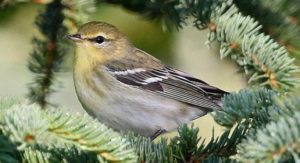When you’re out chasing fall migrants and you either have a good internal compass or you’re

Fall blackpoll warbler winner of the long-distance award for warblers. Migrates more than 1,500 miles one-way. Creative commons photo
somewhere it’s pretty easy to orient yourself to the cardinal directions, like the Blue Ridge Parkway, it’s not unusual to find mixed flocks of migrants moving in what appears, intuitively, to be a “wrong” direction. You may find groups of birds moving north, or east, or west rather than the general southwest route we expect here in the mountains of Western North Carolina. These early morning flights – usually just after sunrise – are called “redetermined” flights.
Researchers from Cornell University, University of Massachusetts Amherst, Mount Holyoke College and the Cornell Lab of Ornithology looked at this phenomenon in 2010 and published a report November 2014 in the “Auk.” The group tried to coordinate multiple sources in their data gathering. They relied upon direct observations, Doppler weather radar, acoustic recordings and information from the U.S. National Oceanic and Atmospheric Administration. They looked at costal as well as inland migration. They noted that this morning redetermined flight was directly related to nocturnal migration and that it represented an extension of the previous night’s migration.
One of the primary reasons for these redetermined flights appears to be to compensate for wind drift. This seems to be more prevalent along the coast where southeasterly winds tend to push birds out over the open water. While the vast majority of migration takes place inland, the largest morning flights were noted along the coast. Researchers observed, “Given the potential dangers of being swept out to sea during their next night of migration, it would make sense for birds that find themselves somewhat near the coast at dawn to move farther inland, independent of any calculated deviation from an intended migratory course.”
Topography and appropriate stopover habitat also play a part in redetermined flights. The report pointed out a site in Greenwich, Connecticut where the early morning flight was directed in a north-northwesterly direction – clearly no shortcut to Central America. But it appears this redetermined flight funnels migrants through a valley in a ridge, which in turn makes their normal southwesterly route more accessible – like it might be easier and faster to get to Brevard from Waynesville by going east to Asheville along I-40 then taking I-26 south and ultimately southwest on Hwy. 280 rather than just going south-southwest along U.S. 276, up and over the Blue Ridge Parkway.
Suitable stopover habitat is critical. Just as armies march – birds fly on their stomachs. Migration is hard work and while most migrants have certainly worked to build up fat reserves before migration but there’s still the day-to-day refueling and rest requirements. Migrating birds use suitable stopover habitat the way we use service station and rest areas – places to refuel and rest.
But there have to be other factors too. Studies of morning flights in the Appalachians show that even in areas where suitable habitat tends to spread in all directions and on nights where wind drift wasn’t an issue redetermined flights still occurred, albeit mostly in the direction of migration. While researchers don’t have a clear answer why – given the benefits of nocturnal migration – birds would wait till morning to reorient. But there are clues; recent studies seem to point to sunrise and sunset as times providing the primary signals birds use to orient themselves during migration. So just like you like to check your map or GPS one last time before getting some needed rest, birds may use the early morning to be sure they’re on course before they pack it in for the day.
